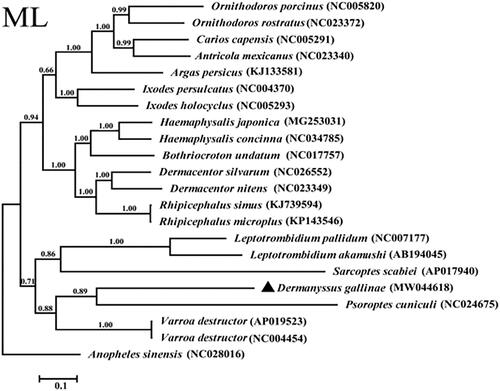Abstract
The complete mitochondrial genome of Dermanyssus gallinae isolated from China is reported for the first time in this study. Its entire mitogenome is 16, 184 bp in length, contained 13 protein-coding genes, 2 ribosomal RNA genes, 21 transfer RNA genes, and 1 non-coding region. The phylogenetic analysis by maximum likelihood method show that D. gallinae isolated from China is in the same clade with the genus of Psoroptes. This is the first complete mitochondrial genome of D. gallinae.
Dermanyssus gallinae, a cosmopolitan hematophagous ectoparasite of birds, is one of the most economically deleterious ectoparasites affecting egg-laying hens worldwide (Cafiero et al. Citation2019). The infestation burden on caged laying hens can be up to 500,000 mites per bird in severe cases (Kilpinen Citation2005). In addition to blood loss, as a consequence, the welfare, health and productivity of the birds are severely affected (Cosoroaba Citation2001). Dermanyssus gallinae could serve as a vector for a number of viral and bacterial avian pathogens (Chu et al. Citation2015). Although several research on D. gallinae have done, there is no report on the complete mitochondrial genome. In this study, the complete mitochondrial genome sequence of D. gallinae was obtained, which provided a basis for the classification of the genus Dermanyssus.
The adult of D. gallinae were collected on a chicken farm, Xingtai City, Hebei Province, China (latitude 114.48, longitude 37.07), on 19 June 2019. Individual mite was stored in the Department of Parasitology, Heilongjiang Bayi Agricultural University (qiaocheng Chang; [email protected]) under the voucher no. BYNKPL-190619. DNA was extracted from tissues using TruSeq DNA sample Preparation kit. The library with insert size of 400 bp fragments was constructed and sequenced using the Illumina HiSeq platform in Personalbio (Nanjing, China). Illumina paired-end sequencing generated a total of 23,050,688-bp raw reads after removing adapters. A5-miseq and MITOS (Bernt et al. Citation2013) were utilized for mitogenome assembly and annotation, respectively. The concatenated nucleotide sequences of 13 proteincoding genes were analyzed with maximum likelihood (ML).
The total length of the D. gallinae mitochondrial genome was 16,184 bp (GenBank accession no. MW044618), which contained 13 protein-coding genes (cox1-3, nad1-6, nad4L, atp6, atp8, and cytb), 2 rRNA genes, 21 tRNA genes, and 1 non-coding region. The D. gallinae mt genome encoded 3,623 amino acids in total and the concatenated amino acid sequences of 13 protein-coding genes were analyzed with the maximum-likelihood method, using Anopheles sinensis (GenBank accession no. NC028016) as the outgroup. The result shows that D. gallinae isolated from China is in the same clade with the genus of Psoroptes ().
Date availability statement
The genome sequence data that support the findings of this study are openly available in GenBank of NCBI at (https://www.ncbi.nlm.nih.gov) (https://www.ncbi.nlm.nih.gov/) under the accession no. MW044618.
Disclosure statement
No potential conflict of interest was reported by the author(s).
Additional information
Funding
References
- Bernt M, Donath A, Juhling F, Externbrink F, Florentz C, Fritzsch G, Putz J, Middendorf M, Stadler PF. 2013. MITOS: improved de novo metazoan mitochondrial genome annotation. Mol Phylogen Evol. 69(2):313–319.
- Cafiero MA, Barlaam A, Camarda A, Radeski M, Mul M, Sparagano O, Giangaspero A. 2019. Dermanysuss gallinae attacks humans. Mind the gap!. Avian Pathol. 48(Sup1):S22–S34.
- Chu T, Murano T, Uno Y, Usui T, Yamaguchi T. 2015. Molecular epidemiological characterization of poultry red mite, Dermanyssus gallinae, in Japan. J Vet Med Sci. 77(11):1397–1403.
- Cosoroaba I. 2001. Massive Dermanyssus gallinae invasion in battery-husbandry raised fowls. Revue de Médecine Vétérinaire. 152:89–96.
- Kilpinen O. 2005. How to obtain a bloodmeal without being eaten by a host: the case of poultry red mite, Dermanyssus gallinae. Physiol Entomol. 30(3):232–240.

